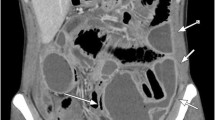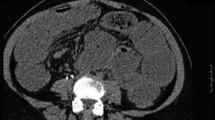Abstract
Perforation of the cecum at needle suspension of the bladder neck was detected at abdominal surgery for recurrent stress urinary incontinence 4 years later.
Similar content being viewed by others
References
Karram M, Bhatia NN. Transvaginal needle bladder neck suspension for stress urinary incontinence: a comprehensive review.Obstet Gynecol 1989;73:906–914
Karram MM. Transvaginal needle suspension. In: Hurt WG, ed. Urogynecologic surgery. Gaithersburg: Aspen, 1992:61–72
Tanagho EA. Colpocystourethropexy: the way we do it.J Urol 1976;116:751–753
Diaz DL, Fox BM, Walzak MP, Nieh PT. Endoscopic vesicourethropexy: experience and complications.Urology 1984;24:321–323
Author information
Authors and Affiliations
Additional information
Editorial Comment: When performing needle urethral suspension procedures there are a number of precautions that can be taken to avoid the most common complications, including intravesical suture placement, ureteral obstruction and bowel perforation. Trendelenburg positioning during these procedures can help to displace the bowel. Additionally, as the authors discuss, these injuries can be avoided by adequate dissection of the retropubic space, and by proper placement of the suprapubic incisions for the needle. This editor recommends placement of the needle approximately 1–2 cm lateral to the urethrovesical junction, and at the level of the pubic symphysis. Procedures in which the retropubic space is dissected, such as the Pereyra procedure, allow the surgeon to direct the needle vaginally along the posterior aspect of the symphysis with a finger in the retropubic space. Needle procedure such as the Raz, the Stamey and the Gittes procedures do not allow for this. Finally, cystoscopy after needle placement is an essential part of these procedures to detect intravesical suture material and/or bowel. The authors present the case of a rare, but potentially serious, complication of needle suspension procedures for the treatment of stress incontinence. The patient in this case had previously undergone two prior intra-abdominal procedures, which placed her at risk for intraperitoneal bowel adhesions and bowel perforation with a needle suspension procedure.
Rights and permissions
About this article
Cite this article
Tamussino, K., Zivkovic, F., Lang, P.F.J. et al. Unrecognized perforation of the cecum at needle suspension of the bladder neck: a case report. Int Urogynecol J 6, 355–356 (1995). https://doi.org/10.1007/BF01892747
Issue Date:
DOI: https://doi.org/10.1007/BF01892747




